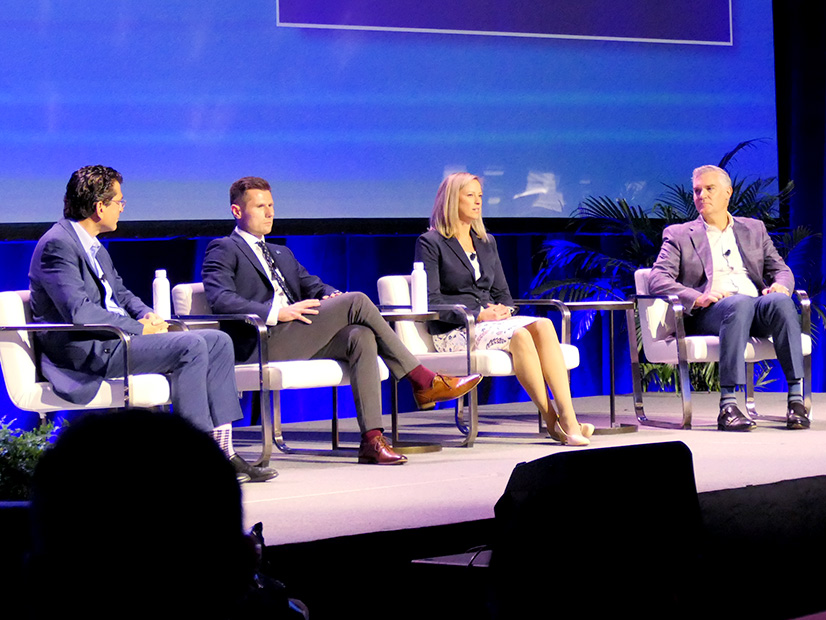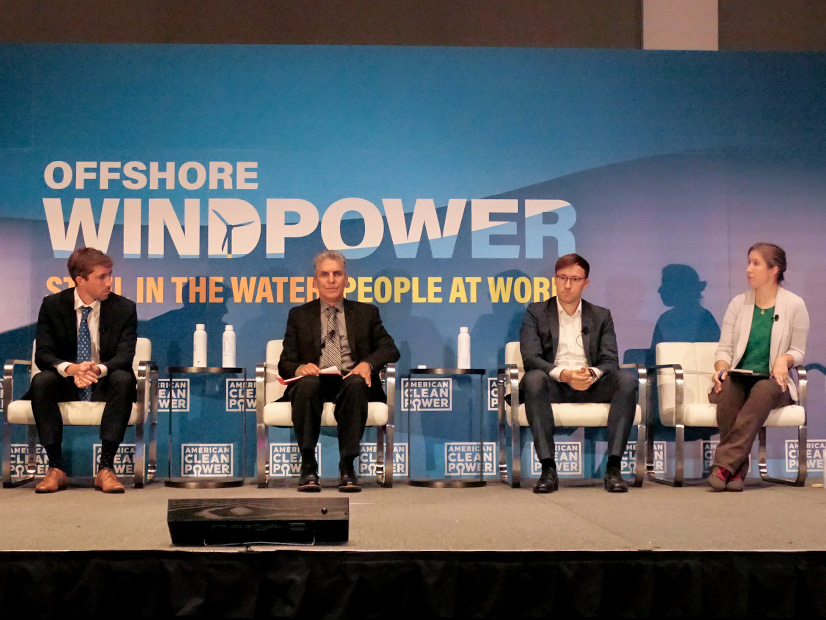
BOSTON — With construction underway for the country’s first large offshore wind projects, government, nonprofit and industry representatives from across the U.S. came here to discuss the industry’s progress and prospects for the American Clean Power Association’s Offshore WINDPOWER conference.
The slogan for the conference (“STEEL IN THE WATER. PEOPLE AT WORK.”) — which was featured prominently on the merchandise, the pre-conference trailer video, and screens and posters throughout the convention center — invoked this major first step forward for the industry.
There was great uncertainty about when the next wave of steel will hit the water on the East Coast and the people these projects will employ will get to work. The developers for Massachusetts’ Commonwealth Wind and SouthCoast Wind projects backed out of their power purchase agreements in recent months: Avangrid reached an agreement at the start of this month to exit the PPAs for its Park City Wind project in Connecticut; Rhode Island’s electric distribution company rejected the only bid from its last solicitation; and four New York projects under active development are in limbo as they seek better terms for their contracts.
While developers can rebid projects that have canceled their PPAs at future auctions, the question remains whether they can find a price that states and utilities deem acceptable to pass on to ratepayers. But speakers at the conference argued that it was only a matter of when, not if.
At a panel featuring state legislators from Massachusetts and California, Massachusetts Rep. Jeff Roy (D-Franklin), co-chair of the Joint Telecommunications, Utilities and Energy Committee, urged developers to send in strong bids for the state’s solicitation and boasted about “the most robust wind in the entire contiguous United States right here off the coast of Massachusetts.”
At the same time, Roy said, the state will be faced with difficult questions around “how much are we willing to spend” when the project bids are due at the end of January.
Supply Chain, Interest Rates and Inflation
“It’s easy to focus on the doom and gloom of the moment right now,” Sam Huntington, director of climate and sustainability at S&P Global, said at a panel on global economics and offshore wind. “There’s still a lot of room for optimism. … There’s just a tremendous commitment to this.”
The industry has been hit with “a perfect storm of supply chain snarls,” Huntington said.
Walt Musial, a principal engineer at the National Renewable Energy Laboratory, said cost pressures from high interest rates and expensive commodities like steel should subside in the coming years. However, “there’s still going to be this issue around supply chain deficits and the inability of suppliers to meet demands.”
As countries and developers across the world all look to scale up offshore wind at the same time, the panelists expressed worry that delays could push the next round of projects back into the 2030s.
In the long term, Musial said he remains confident about the industry, calling it a “cornerstone” of New England’s future electricity supply.
“With climate change as a background, we have to do this,” he said.
Søren Lassen, head of offshore wind research for Wood Mackenzie, called the supply chain issues the industry’s “greatest challenge.” He said the combined issues of supply chain constraints, high interest rates and inflation hit the nation’s industry right as it was trying to make the jump from a small, subsidized industry to the commercial scale.
Lassen said these setbacks could put national and statewide clean energy commitments in jeopardy: An August report by his firm found governments across the world (excluding China) would need to invest about $100 billion in the supply chain by 2026 to meet their 2030 offshore wind goals. (See Report Quantifies OSW Supply Chain Constraints.)
“We don’t think that’s feasible, to be frank,” Lassen said.
Supply chain constraints could also be the limiting factor for the size of offshore wind turbines, which have increased rapidly in recent years. While Huntington said that larger turbines could be the key to lower costs in the long term, Musial cautioned that further increases in blade sizes will only put additional stress on the existing supply chains.
Musial said that industry should “double down” on 15-MW turbines to flatten the learning curve and bring costs down.
For context, Vineyard Wind 1 is being constructed with 13-MW turbines, while Vestas has been testing its 15-MW prototype this year, and General Electric is developing an 18-MW prototype.
“Any attempt to go larger than [15 MW] will just delay progress,” Musial said.
On a panel about installation vessels, Graham Tyson of Crowley Wind Services said that the increase in turbine size is an obstacle to investing in new vessels.
Tyson said investors need “a good eight to 10 years of life out of each turbine class” to justify investment in a new vessel, and either overbuilding or underbuilding the size of the ship poses significant risks.
“You want to know that there’s work for it,” Tyson said.
Federal Support Needed
Speakers throughout the conference called for more federal support for states and developers to help overcome the industry’s recent struggles.
“States cannot do this alone,” said Catherine Klinger Kutcher, director of the New Jersey Governor’s Office of Climate Action and the Green Economy, adding that the state remains committed to offshore wind.
In mid-September, the governors of Connecticut, Maryland, Massachusetts, New Jersey, New York and Rhode Island signed a joint letter asking President Joe Biden for additional federal help for the industry. (See Northeast Governors Ask Feds to Assist OSW Industry.)
“Without federal action, offshore wind deployment in the U.S. is at serious risk of stalling because states’ ratepayers may be unable to absorb these significant new costs alone,” the governors wrote, citing the cost pressures of inflation, lingering supply chain disruptions and Russia’s invasion of Ukraine.
The governors asked Biden for updated guidance on the available clean energy tax credits, a new revenue sharing program for offshore wind leases and a streamlined clean energy permitting process.
In her keynote speech to the conference, Massachusetts Gov. Maura Healey (D) emphasized the importance of federal support, calling for additional resources while applauding the steps that the Biden administration has already taken.
“We can only control so much as states,” Healey said. “We need all parts of the federal administration to work with us to understand that this is our moment.”
Others expressed concern about the effects a new president — presumably Donald Trump, whose name was often implied but infrequently mentioned by speakers — could have on the industry and clean energy efforts more broadly.
Stakeholders should make the best possible use of the Inflation Reduction Act, said Damian Bednarz, managing director of Attentive Energy. “We cannot take any of this for granted,” he said.
SouthCoast CEO Francis Slingsby said stakeholders must specifically push to expedite clean energy permitting processes under the current administration and “make hay while the sun shines.”


